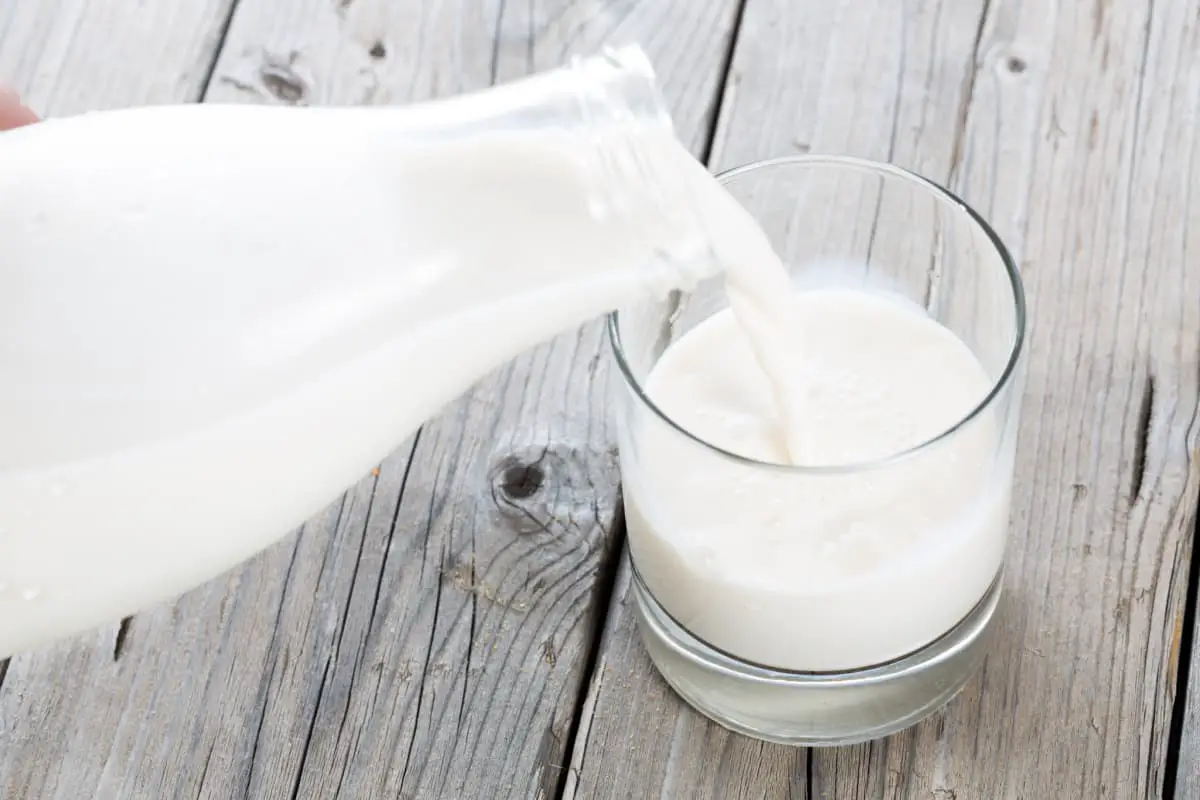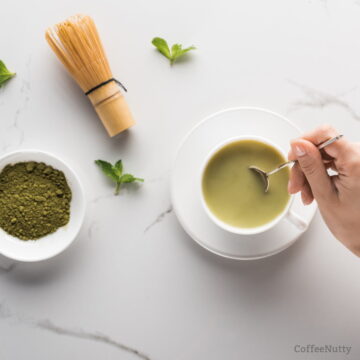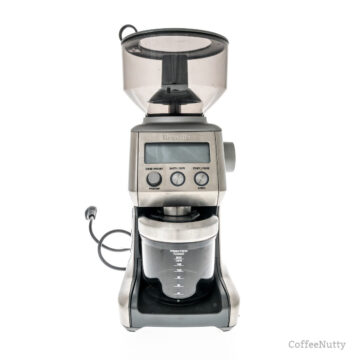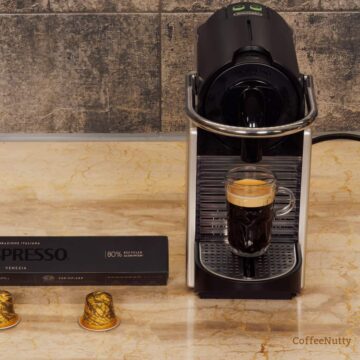Maybe you’re hankering for a latte and spot your coffee maker. The idea occurs to you that maybe you could brew a cup of coffee with milk, instead of water, to save time. But you’re not sure if putting milk in a coffee maker is a good idea.
You can’t put milk in a coffee maker because it will destroy the coffee maker and burn the milk. Coffee makers are designed to be brewed with water and reach about 200 degrees Fahrenheit. Milk is made up of
- Water
- Proteins
- Fats
- Lactose
Steamed milk scalds at 160 degrees. The milk residue left behind will coat the inside of the coffee maker and ruin it.

If you are wondering why trying to put milk in a coffee maker is not a good idea, it’s because milk is more complex than water and doesn’t heat up the same way. We’ll discuss why putting milk in a coffee maker isn’t a good idea.
Can You Put Milk in a Coffee Maker?
If you try to put milk in your coffee maker to make a latte or cappuccino, you’ll only get one good pot. Because the residue left behind from the burned milk will ruin the insides of your coffee maker. In addition to that, the milk will taste burned and ruin your coffee experience.
Coffee makers are designed to heat water up to 197.6 degrees Fahrenheit to get that perfect cup of brewed coffee but will often take between 8-10 minutes to heat up.
In addition to that, the hot plate under the coffee pot continues to maintain a steady temperature to keep the coffee hot.
If you use milk instead of water, the milk inside the coffee pot will continue to scald and make your coffee taste terrible.
How A Coffee Maker Makes Coffee
A coffee maker is designed to make coffee with water. How it works is pretty simple.
- The water you poured into the coffee pot fills the water reservoir and levels out.
- It goes down into a hole at the bottom and into a tube.
- The tube snakes past a heating element placed at the bottom of the pot.
- Once you turn the coffee maker on, the heating element heats up using an electric current.
- This heating element not only heats the water to about 195 degrees Fahrenheit but keeps the hot plate at a consistent temperature.
- As the water heats up, it forms air bubbles and water droplets.
- The water droplets begin to rise and goes up through another small tube and out the shower head.
- A one-way valve keeps the water from going back up into the reservoir.
- The water droplets drip through the coffee grounds and into the pot.
What Happens to Milk When It’s Heated Up
Milk is a complex liquid made up of several components.
It’s made up of
- Almost 88 percent water
- Five percent lactose
- Three percent fat
- Four percent protein
If milk hasn’t been pasteurized, then the fats and proteins usually rise to the surface and can be skimmed off for cream.
However, when pasteurized milk is heated up, all of the ingredients that make it up begin to separate. This happens at about 100 to 120 degrees Fahrenheit.
These ingredients begin to separate and float on the surface of the milk, forming a “skin.”
The “skin” creates a barrier and as the milk heats up toward 160 degrees Fahrenheit, the water vapor tries to escape.
As the milk continues to boil at about 200 degrees Fahrenheit, more steam builds up until the creamy layer is pushed aside and the milk will boil over.
The quality and taste of the milk changes after it boils and can ruin a good latte.
After the boiled milk has cooled, it leaves behind a sticky, filmy residue. This can be very difficult to clean. Especially with the tiny tubing in the coffee maker. And if anything is missed, the milk residue will spoil and go bad.
As an Amazon associate, I earn from qualifying purchases.
Other Ways to Add Milk to Coffee
Instead of adding milk to your coffee maker to make a latte or cappuccino, there are other ways to get the same effect without ruining your coffee maker.
It’s easy to add cream and sugar to regular coffee for a tasty drink. But if you are looking for a homemade latte or other fancy drink, there are ways to froth your milk and get the same affect.
The first step is to steam the milk. If you don’t have an espresso maker or other way to steam milk, then you can either do this in the microwave or on the stove.
To steam milk in the microwave,
- Heat it up in a glass container for about 30 seconds
- Stir the milk or swirl it around to evenly distribute the heat
- Heat it up for another 30 seconds.
To steam milk on the stove,
- Heat milk up in a pot on medium heat
- Continually stir the milk gently, until it reaches 140 to 160 degrees Fahrenheit.
- Use a thermometer to watch the temperature.
- If you don’t have a thermometer, keep an eye on it until the milk is starting to get heated all the way through. Maybe about five minutes.
The second step is to froth the milk.
- You can use a frothing wand to froth the steamed milk.
- If you microwaved the milk in a container with a lid, you can shake the container vigorously for about 30 seconds to froth it.
- You can use a French press to froth the milk by pouring the steamed milk into the flask and moving the plunger up and down until it creates frothy bubbles in the milk.
- You can use a whisk and briskly agitate the steamed milk until it creates a froth.
The third step is to pour it over a cup of hot coffee and enjoy.
You can make your coffee in a coffee maker or in a French press. But either way, steamed milk can add a delicious flavor and texture to your morning cup of joe.
How to Clean Out a Coffee Maker
If you have put milk in a coffee maker by mistake and need to clean it up, the best options are to use a vinegar solution and run it through the coffee maker several times.
- Fill the water reservoir halfway with vinegar
- Fill it the rest of the way with water
- Place a coffee filter in the basket, just in case, to catch any solid debris in the coffee maker
- Brew the mix until half of it is gone through the system.
- Turn the coffee maker off for about an hour
- Turn it back on and finish brewing the rest of the solution
- Repeat the process until the water runs clean and doesn’t smell like sour milk.
- Brew fresh water in the coffee maker to rinse it out.
Don’t Put Milk in a Coffee Maker
Coffee Makers are especially designed to brew drip coffee using water. They are not designed to use any other type of liquid to make coffee.
Don’t put milk in a coffee maker as it can scald and leave a sticky residue on the inside of your coffee maker. This gums up the works and prevents you from enjoying another pot of freshly brewed coffee.
Burnt milk can also ruin the taste of a perfectly good cup of coffee. And if not properly cleaned out, the milk residue will sour and leave a spoiled taste behind.
Use water in your coffee maker and add milk later to enjoy a fresh cup of coffee again and again.
RELATED:





